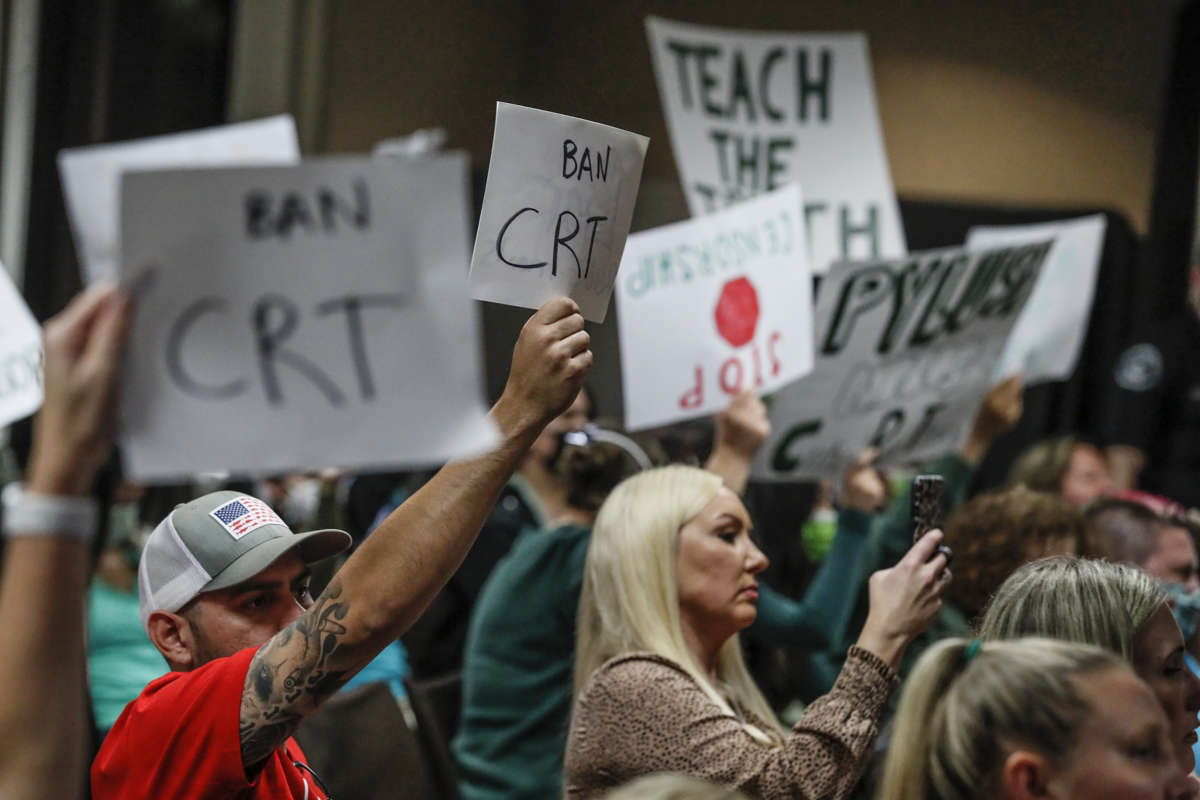Critical race theory (CRT) has become a new bogeyman in conservative circles in the United States. Right-wing groups are applying the term indiscriminately, using it inaccurately as a catch-all buzzword to stand in for everything they oppose, including any discussion of systemic racism in the classroom.
But as critical race theorist Gary Pellar recently pointed out, CRT, an academic discipline that has been around for more than 40 years, “in the real world, describes the diverse work of a small group of scholars who write about the shortcomings of conventional civil rights approaches to understanding and transforming racial power in American society. It’s a complex critique that wouldn’t fit easily into a K-12 curriculum.”
The current right-wing panic surrounding the idea of CRT speaks volumes of the impact of former President Donald Trump and of Trumpism in early 21st-century U.S. The frenzy occurring over the idea that schoolteachers would dare to discuss racism — or be in any way inspired by an academic discipline that seeks to reveal how “colorblindness” is an inadequate goal because of the many ways in which racial power continues to be exercised in supposedly “colorblind” institutions — reveals the unmistakable hold that overt racism continues to have among large segments of the white U.S.
For a better understanding of what CRT is and what it is not, Truthout reached out to one of the key founders of CRT, Richard Delgado, the John J. Sparkman Chair of Law at the University of Alabama. Professor Delgado — the author of 30 books and one of the most-cited legal scholars on race and the law in the country — has become a target of numerous threats by racist and neo-fascist elements since the recent right-wing campaign against CRT began.
C.J. Polychroniou: Professor Delgado, I would like to ask you to describe to us where CRT comes from, and then to discuss in some detail what CRT is and what it is not.
Richard Delgado: CRT stems from critical legal studies and, a little before that, the Frankfurt School of Critical Theory, which is most closely associated with the work of Max Horkheimer, Theodor W. Adorno, Erich Fromm and Herbert Marcuse. My book with Jean Stefancic, Critical Race Theory: An Introduction, describes these intellectual origins.
As a self-aware, cohesive movement, CRT began when a small group of scholars of color asked the Conference on Critical Legal Studies to include a panel on race at their 1986 conference in Los Angeles. Early writing by Derrick Bell, Allen Freeman, myself and a few others had laid a foundation and demonstrated that a left-leaning exploration — like that of critical legal studies, that built exclusively on a foundation of class analysis but not race — could not fully explain modern-day currents. Other intellectual influences include Black liberationist writing, radical Chicano writers and Marxism.
CRT is primarily a graduate field of law and legal studies. Today, though, it has spread to many other disciples, including American studies, education, sociology, political science and philosophy, and to other countries. Some K-12 teachers introduce certain of its principles in high school classes, which has become a source of high controversy.
Given that CRT has been around for several decades, why has it become such a controversial issue in today’s U.S.?
Three reasons stand out, in my own view. First, some disappointed followers of Trump were upset with the results of the recent election and went in search of a boogeyman. Second, certain white supremacists are concerned over the impending demographic tipping point and fear that white American society is in danger of being replaced by one of color. The third reason is the pandemic, which saw many schoolchildren spending a lot of time at home. Many of their parents were shocked to learn that their children had attitudes and beliefs that were anathema in their social circle.
Some skeptics have wrongly asserted that CRT rejects affirmative action, while others appear anxious that CRT attacks the entire liberal order. How do you respond to such criticisms?
CRT doesn’t really reject affirmative action, although many critics think that it doesn’t go far enough. But it does question many liberal mainstays, such as “colorblindness,” or the notion that the “rule of law” is slowly but surely improving the fortunes of people of color.
Some states are proposing passing legislation to ban the teaching of a basically academic concept. Is CRT actually being taught to K-12 public school students?
I certainly hope so. How many people learned in school about the Mexican orphan train, or about the flat-out lies that led to Japanese internment or the Trail of Tears?
As a founder of CRT, you have been lately the target of scores of hate messages. Are you concerned about these hate messages turning into real-life violence against you and your wife?
A recent anonymous phone message offered to put a bullet in my brain. Another told me to go back to Mexico if I didn’t like it here. A third warned me that my subcompact car could suffer a serious accident with a truck in Tuscaloosa.
A university administrator told me they could do nothing about the threats unless they were specific and imminent but referred me to campus police.
3 Days Left: All gifts to Truthout now matched!
From now until the end of the year, all donations to Truthout will be matched dollar for dollar up to $38,000! Thanks to a generous supporter, your one-time gift today will be matched immediately. As well, your monthly donation will be matched for the whole first year, doubling your impact.
We have just 3 days left to raise $38,000 and receive the full match.
This matching gift comes at a critical time. As Trump attempts to silence dissenting voices and oppositional nonprofits, reader support is our best defense against the right-wing agenda.
Help Truthout confront Trump’s fascism in 2026, and have your donation matched now!
